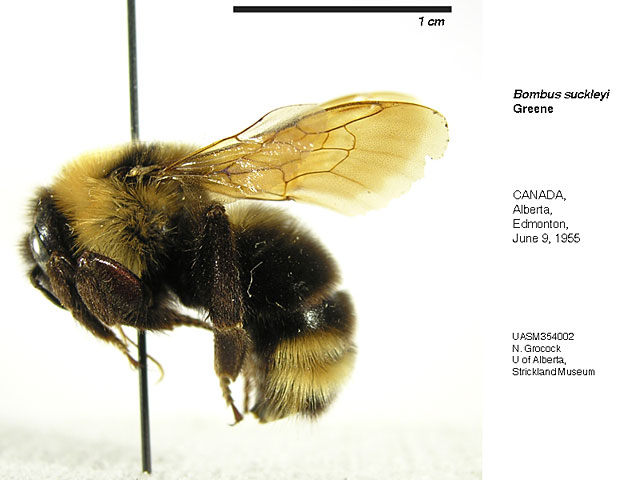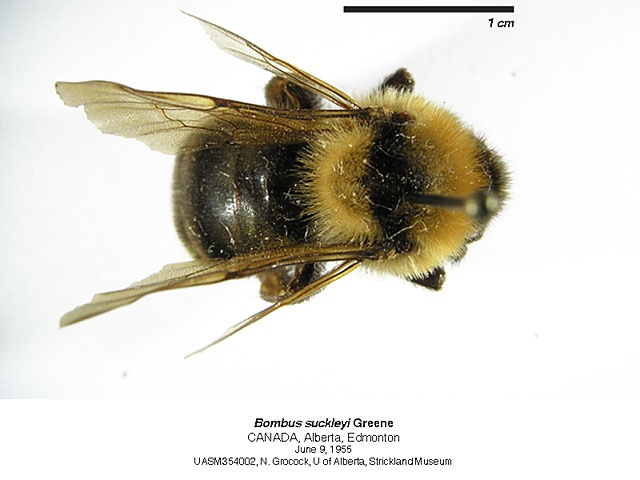Species Details
Bombus suckleyi
University of Alberta E.H. Strickland Entomological Museum Read more about this collection »
SeasonalityFemales fly from late May to late October, and males from early July to late October (Thorp et al., 1983).
IdentificationBombus suckleyi belongs to the subgenus Psithyrus, in which the majority of species are parasitic and females lack pollen gathering and manipulating structures found in other Bombus (Michener, 2000). Psithyrus has been traditionally treated as a separate genus from Bombus. However, further classification based largely on male genitalia and cladistics analysis suggests that Bombus and Psithyrus should be treated as subgenera (Michener, 2000). Bombus suckleyi is distinguished from other species of subgenus Psithyrus by a number of characters. Firstly, the malar space, the area from the bottom of the compound eye to the base of the mandible, is wider than it is long. Second, the volsella, a cluster of sclerites on the ventral part of male genitalia, is broad and triangular beyond the gonostylus. Lastly, the penis valve lacks the median lateroventral tooth (Thorp et al., 1983). The face and cheeks of B. suckleyi are dark, while the occiput is covered in considerable yellow pile (Franklin, 1912). The dorsum of the thorax is yellow with a narrow, black interalar band. Segments one, three, and four of the abdomen are yellow, although segment three may have dark pile on the anterior corners and front margin. The second segment is dark on the sides and typically the apical margin, with yellow pile in the middle. The fifth and sixth segments are dark in the middle with considerable yellow pile on the sides and segment seven is dark. The wings are stained with brown and are almost subhyaline. The length of the body is between 13 to 14 mm, and the wingspan is 32 mm.
Scientific Name
Bombus suckleyi
Habitat
Many habitats due to its parasitic lifestyle in nests of other bumblebees (Thorp et al., 1983).
Seasonality
Females fly from late May to late October, and males from early July to late October (Thorp et al., 1983).
Identification
Bombus suckleyi belongs to the subgenus Psithyrus, in which the majority of species are parasitic and females lack pollen gathering and manipulating structures found in other Bombus (Michener, 2000). Psithyrus has…
Bombus suckleyi belongs to the subgenus Psithyrus, in which the majority of species are parasitic and females lack pollen gathering and manipulating structures found in other Bombus (Michener, 2000). Psithyrus has been traditionally treated as a separate genus from Bombus. However, further classification based largely on male genitalia and cladistics analysis suggests that Bombus and Psithyrus should be treated as subgenera (Michener, 2000). Bombus suckleyi is distinguished from other species of subgenus Psithyrus by a number of characters. Firstly, the malar space, the area from the bottom of the compound eye to the base of the mandible, is wider than it is long. Second, the volsella, a cluster of sclerites on the ventral part of male genitalia, is broad and triangular beyond the gonostylus. Lastly, the penis valve lacks the median lateroventral tooth (Thorp et al., 1983). The face and cheeks of B. suckleyi are dark, while the occiput is covered in considerable yellow pile (Franklin, 1912). The dorsum of the thorax is yellow with a narrow, black interalar band. Segments one, three, and four of the abdomen are yellow, although segment three may have dark pile on the anterior corners and front margin. The second segment is dark on the sides and typically the apical margin, with yellow pile in the middle. The fifth and sixth segments are dark in the middle with considerable yellow pile on the sides and segment seven is dark. The wings are stained with brown and are almost subhyaline. The length of the body is between 13 to 14 mm, and the wingspan is 32 mm.
Life History
Female Bombus suckleyi are social parasites that invade the colony of at least 6 other subgenera of bumblebees, and are typically associated with subgenera Bombus and Pyrobombus (Thorp et al., 1983). In Canada,…
Female Bombus suckleyi are social parasites that invade the colony of at least 6 other subgenera of bumblebees, and are typically associated with subgenera Bombus and Pyrobombus (Thorp et al., 1983). In Canada, Psithyrus species are more prone to invade colonies of early-emerging Bombus species than those that emerge later in the season (Hobbs, 1967). Cuckoo bees of the subgenus Psithyrus rely on both olfactory and visual cues to locate the nests of host bumblebees (Hobbs, 1966). Hobbs (1966) noted that B. fervidus, and presumably other Bombus, workers attempt to defend the colony against B. suckleyi and other Psithyrus by dabbing them with honey or by stinging the invader (Alford, 1975), although these behaviours do not always prevent them from rearing a brood. When entering a colony, the female will draw her legs up to her body and remain motionless in order to avoid being attacked by workers. If the invasion is successful, the female B. suckleyi may kill the queen of the host colony, or they may live in harmony after the Psithyrus female assumes the role of queen (Alford, 1975; Michener, 2000). She will then begin to construct egg cells and rapidly deposit eggs of her own, which are typically longer, more slender, and less curved than eggs of the host (Alford, 1975). During the construction of egg cells, she may consume the brood of the host and reuse the wax for her own purposes. Bombus suckleyi lacks a worker class, relying on the workers of the host colony to rear the brood, which develop relatively quickly into reproductive progeny that can mate before the female develops her fat body, overwinters, and later invades a new host colony.
Conservation
Population trends of cuckoo bees of the subgenus Pyrobombus tend to follow those of their hosts (Schweitzer et al., 2012). As Bombus suckleyi are associated with many hosts in at least 6 subgenera of bumblebees, B.…
Population trends of cuckoo bees of the subgenus Pyrobombus tend to follow those of their hosts (Schweitzer et al., 2012). As Bombus suckleyi are associated with many hosts in at least 6 subgenera of bumblebees, B. suckleyi populations are expected to be stable. However, in North America they are rapidly declining. The IUCN lists B. suckleyi as critically endangered, and states that the population trend is decreasing.
Diet Info
Adult Bombus suckleyi are polylectic and have been observed feeding on 4 families of flowers in 8 genera including: Aster, Centaurea, Cirsium, Haplopappus, Melilotus, Penstemon, Salix, and Solidago (Thorp et al., 1983).
Adult Bombus suckleyi are polylectic and have been observed feeding on 4 families of flowers in 8 genera including: Aster, Centaurea, Cirsium, Haplopappus, Melilotus, Penstemon, Salix, and Solidago (Thorp et al., 1983).
Range
Nearctic distribution (Thorp et al., 1983). West of 95° longitude, from the Northwest Territories, to Nebraska and west, from Alaska to California.
Publications
Author
Schweitzer, D. F., Capuano, N. A., Young, B. E., & Colla, S. R.
Title
Conservation and Management of North American Bumble Bees
Publication Date
2012
Author
Michener, C. D.
Title
The Bees of the World.
Publication Date
2000
Pages
913 pp
Author
Thorp, R. W., D. S. Horning Jr. and L. L. Dunning
Title
Bumble bees and cuckoo bumble bees of California (Hymenoptera: Apidae).
Publication Date
1983
Series Title
Bulletin of the California Insect Survey
Volume
23
Pages
viii + 79 pp.
Author
Alford, D. V.
Title
Bumblebees.
Publication Date
1975
Pages
352
Author
Hobbs G. A.
Title
Ecology of species of Bombus Latr. (Hymenoptera, Apidae) in southern Alberta. VI. Subgenus Pyrobombus.
Publication Date
1967
Series Title
The Canadian Entomologist
Volume
99
Pages
1271-1292
Author
Hobbs G. A.
Title
Ecology of species of Bombus Latr. (Hymenoptera, Apidae) in southern Alberta. V. Subgenus Subterramobombus Vogt.
Publication Date
1966
Series Title
The Canadian Entomologist
Volume
98
Pages
288-294
Author
Franklin H. J.
Title
The Bombidae of the New World, part I.
Publication Date
1912
Series Title
Transactions of the American Entomological Society
Volume
38
Pages
177– 486
Title
IUCN Red List of Threatened Species
Series Title
Ecology
Specimen Information
There are 7 specimens of this Species.
UASM354002 - Bombus suckleyi
University of Alberta E.H. Strickland Entomological Museum
Place CollectedCanada: Alberta, Edmonton
Collected ByBall, G. E.; Ball, K. E.
Date Collected1955-06-09
UASM354003 - Bombus suckleyi
University of Alberta E.H. Strickland Entomological Museum
Place CollectedCanada: Alberta, George Lake
Date Collected1965-07-05
UASM354005 - Bombus suckleyi
University of Alberta E.H. Strickland Entomological Museum
Place CollectedCanada: Alberta, Abee
Collected ByHoreczko, N.
Date Collected1957-05-25
UASM354006 - Bombus suckleyi
University of Alberta E.H. Strickland Entomological Museum
Place CollectedCanada: Alberta, George Lake
Collected ByGraham, P.
Date Collected1966-06-14/1966-06-17
UASM354007 - Bombus suckleyi
University of Alberta E.H. Strickland Entomological Museum
Place CollectedCanada: Alberta, George Lake
Collected ByGraham, P.
Date Collected1966-06-14/1966-06-17
UASM354008 - Bombus suckleyi
University of Alberta E.H. Strickland Entomological Museum
Place CollectedCanada: Alberta, George Lake
Collected ByGraham, P.
Date Collected1966-07-07/1966-07-08
UASM213949 - Bombus suckleyi
University of Alberta E.H. Strickland Entomological Museum
Place CollectedCanada: Alberta, Edmonton
Collected ByAnweiler, G. G.
Date Collected2013-05-28



